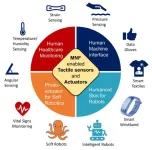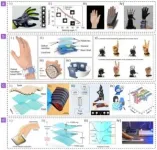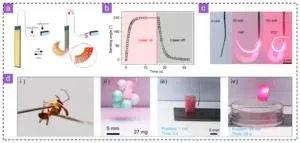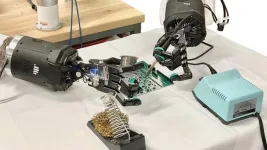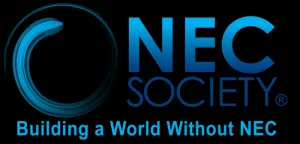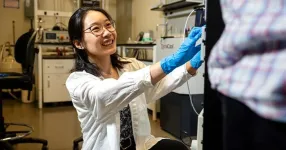A new publication from Opto-Electronic Sciences; DOI 10.29026/oes.2024.240005, discusses advances in optical micronanofiber enabled tactile sensors and soft actuators.
As a perfect combination of fiber optics and micro/nanotechnology, optical micro/nanofiber (MNF) is a new type of micro/nano-waveguide structure developed in recent years. Compared with standard fiber, MNF has smaller diameter and larger core cladding refractive index contrast, so it offers unique optical properties, including low transmission loss, strong light-field constraint, large evanescent field, small bending radius, small mass, and compatibility with standard fiber. Thus, the MNF enabled flexible optoelectronic devices with high sensitivity, small size, low power consumption have been widely used in the fields of tactile sensors and soft actuators. To date, flexible MNF sensors, also named as "optical skin", have been used to monitor pressure, temperature, hardness, pulse and breathing with high sensitivity, fast response, and anti-electromagnetic interference. In addition, the MNF enabled soft actuators provide a new strategy for micromanipulation and micro-robotics. In summary, MNFs have unique properties in the field of flexible optoelectronics and have broad application prospects in the fields of machine haptics, human-computer interaction, medical monitoring, and micro-nano robots.
This review mainly covers two parts of MNF enabled tactile sensors and actuators. Firstly, the manufacture method of MNF tactile sensor is presented from the aspects of fiber drawing, polymer packaging, device preparation and system integration. Then, this review introduces structural design, sensing mechanism, performance characteristics and application fields, such as fingertip/radial pulse and other important physiological indicators monitoring, data gloves, smart wristband, tactile textile and industrial/medical robots (Fig. 1).
In mechanism, MNF enabled tactile sensors can be categorized into taper type (single-cone), double-cone type, resonator type, grating type, interferometer type and micro-coupler type according to their structures. The sensing signal is extracted mainly through wavelength demodulation and intensity demodulation. Wavelength demodulation by tracking the movement of resonant wavelength is mainly used in WGM resonators, FP resonators, Theta resonators, Sagnac resonators, Fiber Bragg Grating, etc. Though high sensitivity, it is worth further optimization and exploration in system integration and miniaturization. Intensity detection is a simpler detection method, which uses miniaturized semiconductor light source and photodiode to monitor the change of MNF's transmittance, so as to realize the miniaturization of sensing system and efficient acquisition of sensing signals. As shown in Figure 2, the MNF enabled data glove, smart wristband, smart textiles, proximity and tactile composite multi-parameter interactive interfaces have realized the systematic integration of light source, photo detectors, and MNF sensors, and demonstrated the characteristics of lightweight, sensitive, low power consumption and anti-electromagnetic interference in the field of human-computer interaction.
On the other hand, MNFs also have the characteristics of small size, light weight, high compliance and strong evanescent field, making the MNF enable photoactuators with large angular deformation, stable and safe clamping of small objects (Fig. 3)
In summary, this paper reviews the cutting-edge progress and highlights of the research work of MNF enabled tactile sensors/actuators and looks forward to the great potential of application in the fields of distributed sensing, soft actuators with the abilities of complex deformation and sensing, and AI-enhanced sensors/actuators.
Keywords: flexible opto-electronic devices / tactile sensors / soft actuators / optical micro/nanofibers
# # # # # #
Lei Zhang is a professor at the College of Optical Science and Engineering, Zhejiang University. His research interests include flexible MNF tactile sensors/actuators and optofluidic MNF sensors. He has presided and participated in a number of national and provincial scientific research projects, and published more than 60 academic papers in international top journals such as Nat. Commun., Adv. Mater., Opto-Electron. Adv. and Lab Chip.
Website: https://person.zju.edu.cn/zhanglei_opt
Limin Tong is a professor at the College of Optical Science and Engineering, Zhejiang University. His research interests include theoretical basis, functional structure and device application of low-dimensional photonics. He has made important progress in the fields of micro/nanofiber and other low-dimensional waveguide structures, nano-lasers, all-optical modulators and on-chip integrated photonic devices. He has published more than 200 academic papers in top journals in Nature, Science, Sci. Adv., Light, Phys. Rev. Lett., etc.
Website: https://person.zju.edu.cn/0097096
Research Group Website: http://www.nanophotonics.zju.edu.cn/
# # # # # #
Opto-Electronic Science (OES) is a peer-reviewed, open access, interdisciplinary and international journal published by The Institute of Optics and Electronics, Chinese Academy of Sciences as a sister journal of Opto-Electronic Advances (OEA, IF=15.3). OES is dedicated to providing a professional platform to promote academic exchange and accelerate innovation. OES publishes articles, reviews, and letters of the fundamental breakthroughs in basic science of optics and optoelectronics.
# # # # # #
More information: https://www.oejournal.org/oes
Editorial Board: https://www.oejournal.org/oes/editorialboard/list
OES is available on OE journals (https://www.oejournal.org/oes/archive)
Submission of OES may be made using ScholarOne (https://mc03.manuscriptcentral.com/oes)
CN 51-1800/O4
ISSN 2097-0382
Contact Us: oes@ioe.ac.cn
Twitter: @OptoElectronAdv (https://twitter.com/OptoElectronAdv?lang=en)
WeChat: OE_Journal
# # # # # #
Zhang L, Zhen YQ, Tong LM. Optical micro/nanofiber enabled tactile sensors and soft actuators: A review. Opto-Electron Sci 3, 240005 (2024). doi: 10.29026/oes.2024.240005
END
